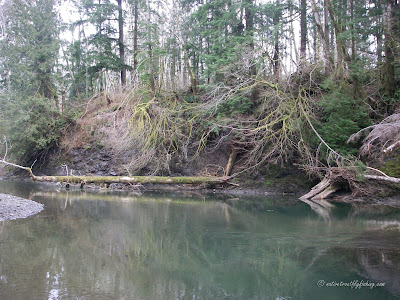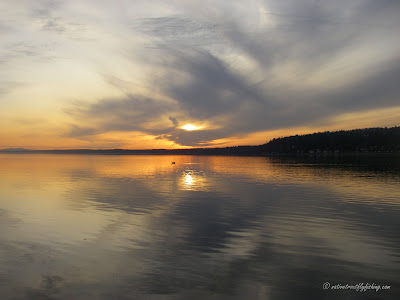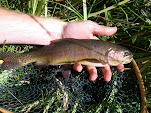Sunday: February 15th 2009: The first river that we fished has its origins in Olympic National Park, and as such the habitat and water quality remain in great shape throughout much of the system. We started our float early in the morning, with air temperatures sitting at a balmy 27 degrees when I dropped my car off at the take out. Lately there really hasn't been much rain, which is very unusual for this time of the year in Washington and needless to say the river was running very low and clear. Clint and I each rigged up with nymph and swinging step-ups, while Tim worked a jig.
 |
| A small tributary entering the river |
We quickly fell into a routine of fishing nymphs while we floated through the abundant pocket water, then getting out at productive runs and side channels to cover the water better. At one such side channel, I was working my way downstream, switching off between nymphing and swinging when Clint yelled from down river that he had a fish on. Seeing the bend in this rod I naturally headed down to see what he had hooked into. However, I was a little surprised to see a Whitefish on the end of this line when I got there. Apparently a whole school was sitting in this small riffle and within a few seconds of me arriving, Clint managed to get another one on his egg imitation. At this point the school was pretty spooked from the thrashing of two of their companions. However, after putting in some effort I was still able to hook into one on my nymph rig, which I LDR'd before the school decided that they didn't want to have anything more to do with us.
 |
| Clint with a Mountain Whitefish caught on a bead |
 |
| High stick nymphing a riffle on a braided section of the river |
A little ways down the river we saw a huge Coho (~15lb) holding in a pool along with a school of smaller fish, but none of them seemed to be too interested in our offerings. This would be the last sign of fish for a while and for the next couple of hours we didn't hook anything and it was just us a few eagles on the river.
 |
| A big Bald Eagle |
 |
| A small side channel of the river (there is a Bald Eagle in one of the trees) |
After a long stretch of 'dead' water, we finally came to a pool where we could see several fish holding. I made a couple of casts with my swinging rig and just as I was about to bring it in to change over to a nymph I got a solid tug and had a fish on the end of the line. I can't say that the fish put up the best fight, but when I got it in I was shocked to see that it was a Sockeye Salmon. Although Sockeye are a rare possibility on the Olympic Peninsula, I never expected to catch one, let alone on a fly. The Sockeye in this part of their range are known for having an unusual spawning coloration and don't generally exhibit the red color that people associate with this species of fish. What made this fish so special for me was that with it I have now caught all five species of Pacific Salmon in their native waters on a fly in Washington State!
 |
| The surprise of the day for me; a hen sockeye caught on "GMOAL" fly |
Monday: February 16th 2009: We headed to a different river for the day and were off to another icy start. In fact until the sun got on the water, icy guides were quite the annoyance and had to be cleared after every couple of casts. Again, the river was way lower than it should be for this time of the year, but this time we at least knew that there were a few fish around as we spooked a decent Steelhead in the first pool.
 |
| Early morning on the river |
 |
| Clint swinging a fly through a great looking run. |
However, after seeing that first Steelhead for the next five hours there was no sign of any fish. This was about to change though, as a couple miles above the take out, Tim got a solid grab and ended up landing a nice six pound hatchery Steelhead.
 |
| Tim with a hatchery steelhead caught on a black jig |
The water below this showed promise, as we saw another couple Steelhead, but were unable to get any more bites and were at the take-out before we knew it.
Wednesday: February 18th 2009: I started the day out helping Dave Shreffler (Dave was one of the other anglers at the winter Steelhead clinic) planting some dune grass at a restoration project along the Strait of Juan de Fuca in Sequim. Dave runs an ecological restoration and consulting firm and when he said that he could use some help, I jumped at the opportunity. This project had been to create a natural berm in place of a concrete bulkhead to protect several homes from being damaged or experiencing erosion due to wave activity. Unlike with a bulkhead, the more natural berm restores natural processes and allows sand and gravel allowed to exchange along the beach. This process is essential for supporting healthy habitat needed for species such as sea-run Cutthroat, juvenile Salmon, Surf Smelt and Pacific Sand Lance.
 |
| Planting dune grass along the berm |
Just as I was about to finish up with my lunch a saw a boil on the other side of the pool that I thought was most likely from a Cutthroat. I switched to a black Strip Tease fly, which I thought might get a Cutthroat's attention and made a few casts with nothing. On the next cast though I landed my fly right next to a log that had slid into the water and it was fish on! It was evident right when I hooked into this fish that it was not the same little Cutthroat that I had seen boil, as this fish was putting a serious bend in my 8 WT. I managed to pull the fish around a big snag that was laying right across the middle of the pool and finally got a good look at it. This was not a Cutthroat at all, but about a 4lb Steelhead, although the way it was fighting suggested it was most likely a spawned out hatchery fish. I thought that I had the fish, but when it was only about ten feet away, the hook popped out and the line went slack leaving me in defeat.
 |
| The pool where I almost caught my first steelhead on a fly... Oh well maybe next time... |
After hooking the Steelhead, I fished my way downstream covering a solid mile and a half of river, which had lots of great looking holding water, but just needed a bit more water. Once I got into the upper reaches of a canyon stretch, the river started to take on a different look and had some nice deep pools.
 |
| The river at the head of the canyon |
One such pool I came across absolutely screamed steelhead, it was a long deep piece of water with submerged undercut ledges on each side and a large downed tree laying in the tail out. To make things better it sat right above a section of fast water making it ideal spot for a steelhead to rest. I started at the head of the pool and began swinging a GMOAL fly through, taking a couple of steps downstream after each cast and repeating the process. I was just about down to the tree in the water when I heard a big splash from just below the tree. I looked in the water right in front of me and saw a big Steelhead of at least 12lbs darting upstream. At this point I was thinking to myself - how in the world did I spook that fish when the tree was blocking the view between me and where it had been holding. That was until I saw something else swimming up the pool. At first I thought fish, but this thing is a whole lot bigger and not swimming like a fish at all. I took me a second to put two and two together, but I was looking at a Beaver, which had been the one responsible for spooking the fish. After a few seconds underwater the Beaver surfaced for about a minute until it noticed me. This caused the beaver to slap its tail on the surface of the water before diving down to the depths again, officially spooking whatever other fish may have been holding in the pool.
 |
| The Steelhead spooking Beaver |
After my run in with the beaver I worked my way downstream to a nice piece of pocket water, which I fished for a bit with no luck before heading up to swing a fly though the pool a few more times. However, after a few casts I could see the beaver swimming across the bottom of the pool again and figured that the steelhead was either spooked or had moved on. This was as good of a sign as any for me to start heading back upstream, as the sun was already starting to get low in the sky.
I made a few casts in each decent looking spot for the first 1/4 mile or so just in case if the Steelhead had moved upstream, but no dice. After this I put it into high gear until I got back to the pool where I had hooked the Steelhead earlier in the day.
Right as I got the the pool, the Steelhead that I had hooked earlier (or its twin) broke the surface of the water causing me to make a few more casts. I ended up throwing about ten different patterns and a hundred casts at this fish, but it didn't seem to have any interest in any of them. It was pretty dark at this point, so I had no choice but to call it quits and make my way back the car the remaining 3/4 mile by headlamp.
















